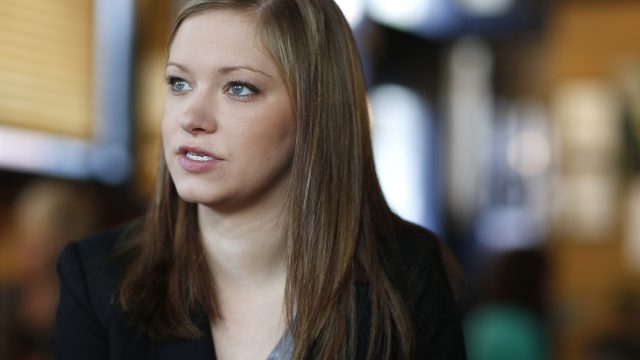Democrats Crossing Over For Doug Burgum Put Their Own Legislative Candidates At Risk

Rep. Kylie Oversen, 26, chairwoman of the ND Democratic Party, is the youngest chair in the U.S. photo by Eric Hylden/Grand Forks Herald
Yesterday, in my newspaper column reacting to the stunning primary results, I did some quick and dirty math on Republican versus Democratic turnout. The Democrat vote was way down, and the Republican vote was way up, which likely means that Democrats crossed over into the Republican column to support Burgum in a big, big way.
This morning I got up early and went a little more in depth with the numbers.
I averaged out the Republican and Democratic turnout for each partisan race on each primary ballot going back to 2000 (I excluded from the averages races where the party didn’t have a candidate), and then divided the Republican turnout by the Democratic turnout to get a ratio (remember that voters who vote for more than one party’s candidates see their ballots disqualified). What we can see, from the resulting numbers, is that 2016 was a very unique year. The Republican-to-Democratic turnout was more than triple the typical primary vote.
I don’t know how to explain it other than a massive influx of historically Democratic voters to the Republican ticket:

In March I asked if Democrats crossing over to the Republican ballots could help put Burgum over the top. The answer now, in June, is yes. Yes they can.
What’s interesting is that Democrats may have crossed over in such large numbers that they actually put some of their legislative candidates at risk, because once they voted for one Republican candidate they couldn’t go back to the Democratic ticket to vote for down-ballot candidates.
Section 16.1-11-36 of the North Dakota Century Code states that primary candidates may not advance unless they receive, at a minimum, a vote total equal to or greater than the number of signatures required to place them on the primary ballot in the first place:

According to section 16.1-11-11, “Candidates may file a Petition/Certificate of Nomination with the Secretary of State containing signatures equal to 1% of the total population of the legislative district. However, no more than 300 signatures are required.”
Legislative districts are apportioned by population, and so have an average population of just over 14,000. That means legislative candidates must get at least 1 percent of 14,000, or about 140 votes give or take, to continue to the general election ballot.
This provision in the law is why none of the Libertarian Party legislative candidates will be on the general ballot. Their Senate candidate in District 42 got 18 votes. Their House candidates in Districts 16 and 46 got 22 and 27 votes, respectively. Well short of the threshold. They’re not advancing.
But a number of Democratic candidates were on the bubble too. Here’s a list, you can see the results for all the legislative races here.
- District 16 Senate candidate Tyler Axness, 249 votes
- District 36 Senate candidate John Fielding, 224 votes
- District 40 Senate candidate Phil Franklin, 205 votes
- District 42 Senate candidate Mac Schneider, 271 votes
- District 2 House candidates Brandon Delvo and and Doug Hoffman, 213 and 233 votes respectively
- District 16 House candidates Ben Hanson and Lisa Dullum, 201 and 223 votes respectively
- District 36 House candidates Dean Meyer and Lisa Kittilson, 208 and 207 votes respectively
- District 38 House candidates Heidi Rintoul and A.J. Schultz, 191 and 159 votes respectively
- District 42 House candidates Kylie Oversen and Grant Hauschild, 254 and 214 votes respectively
It does seem, based on these not-yet-certified results, that all of the Democratic candidates made it. But the margins were pretty thin, and if two of the candidates on the bubble – Senate Majority Leader Mac Schneider and Democratic Chairwoman Kylie Oversen – had failed to make the ballot it would have been an enormous embarrassment for the party.
I got a lot of blowback from Burgum supporters when I pointed out the degree to which Democrats crossed over to vote for him. Obviously, for his conservative supporters who bought into his campaign messaging, the trend is disconcerting.
But looking at this data, it’s clearly real, though Burgum’s margin of victory was so large he may have won without them anyway.




